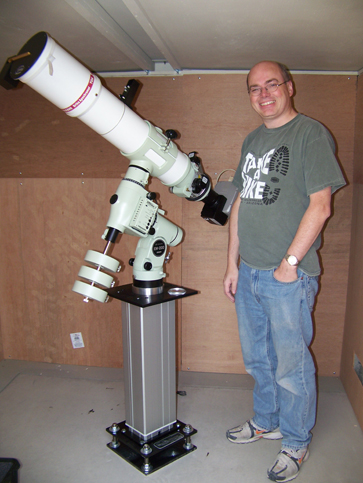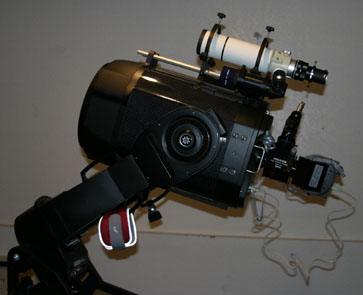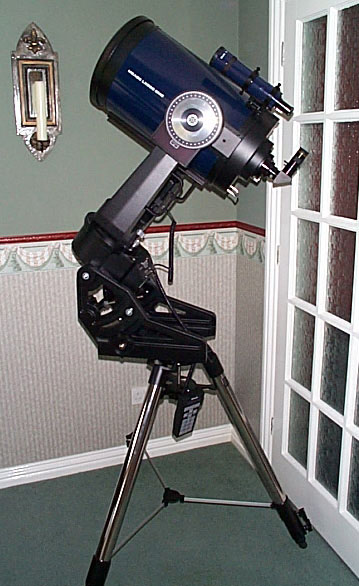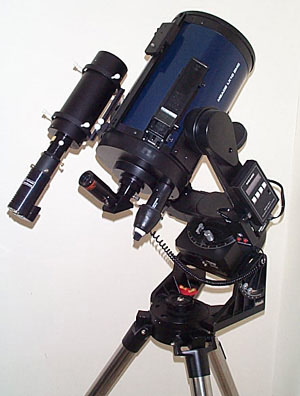| I received my first
telescope, a Meade
LX10 8" SCT, in June 1997 and for the first 6 months used it purely for visual
observation. As with many amateur astronomers I then became tempted to try CCD
imaging lured by the prospect of recording much greater detail than I could see
visually. To this end I purchased a Starlight
Xpress MX516 CCD camera in December 1997. In March 1999 a
Meade 10 inch LX200 was added to the equipment used at Woodlands and in
February 2000 an SBIG
ST-7E CCD Camera and CFW8
Filter Wheel. In October 2005 I replaced the LX200 with a Meade
10 inch RCX400 Ritchey-Chretien. I also upgraded the SBIG ST-7E
to an ST-2000XM
with AO-7 adaptive optics. In 2008 I decided to move my
main imaging setup to a Takahashi
TOA-130 130mm refractor and an STL-11000M with AO-L adaptive optics.
In 2010 I completed construction of a sliding roof observatory to provide a
permanent home for this setup |
|
Takahashi TOA-130 130mm Refractor

In July 2008 I took delivery of a Takahashi TOA-130 and
an EM-200 Temma II Goto mount. At the same time I purchased an SBIG
STL-11000M CCD camera with AO-L adaptive optics. While I had taken
many good images with the RCX400 there were issues with its operation
that could often lead to frustrating imaging sessions. The
tracking of the mount on the RCX-400 is not up to prime focus imaging
even with autoguiding. I had used the AO-7 adaptive optics with my
ST-2000XM CCD camera to overcome this but there were times when the
RCX400 guiding would not operate when the guide star had moved to the
edge of the AO-7 mirror. This would involve rebooting the scope in
the middle of the imaging session to get things working correctly again.
The Takashi EM-200 German Equatorial Mount is much higher quality with
better tracking. I have found that I still need to use adaptive
optics to get perfect tracking but the mount always responds to the
commands to recenter the guide star when it reach the edge of the
mirror. So far the Takahshi has performed flawlessly. It is
easy to get it to reach a crisp focus and it stays in focus a lot longer
than the RCX400. The GOTO is very accurate and so is the mount
tracking. One great thing about the Takahashi is that combined with
the STL-11000M its field of view is a large as that of the ST-2000XM
with the FS-60C. That makes the TOA-130 a great widefield imaging
system while still being able to get down to 1.5 arcsecond/pixel
resolution using the 7.4 micron pixels of the ST-2000XM. In 2010 I
completed a sliding roof observatory to house the setup. The
TOA-130 and EM-200 mount are supported by a
Pier-Tech 2 pier.
This pier can be raised in height at the touch of a button without
losing polar alignment. This allows the telescope to be raised
high enough to see low down in the southern sky even with 6ft high walls
in the Observatory.
|
|
Meade
RCX400 10" Ritchey-Chretien

In October 2005 I purchased a Meade RCX400 10"
Ritchey-Chretien. It has the same GOTO and PEC function as the LX200
but has a number of advantages for the CCD imager. The Ritchey-Chretien
optical design has a fixed primary mirror, so there is no possibility of
the mirror moving during a long exposure and affecting focus and/or image
position. Focus is achieved electronically using the Autostar to
control the movement of the secondary mirror so very precise adjustments
are possible with no shift of the image. A USB hub is provided on
the OTA which allows up to three CCD imagers/autoguiders to be connected,
eliminating dangling cables and cable wrap which may affect
tracking. The USB hub is connected to the PC via a single cable
attached to the base of the telescope. This USB attachment also
allows the PC to control the telescope using the supplied Autostar suite
or other third party software, eliminating the need for the serial cable
required on the LX200. All cameras and the telescope can now be
controlled from one USB connection to the PC. The RCX400 also
supports electronic collimation via the Autostar hand controller or PC
with Autostar Suite. Good collimation is very important if you want
to produce good images, especially of the planets. On the LX200
collimation of the secondary mirror has to be done by manual adjustment of screws
on the secondary. This can be very awkward as you constantly
have to move from the eyepiece to the secondary and back making small
adjustments until collimation is achieved. With the RCX400 you just
use the arrow keys on the Autostar to adjust the secondary mirror while
looking through the eyepiece the whole time. It makes collimation a
whole lot easier. Another useful feature is the built in heater
around the corrector lens, which removes the need for third party dew
removal systems. The RCX400 comes with a much sturdier tripod than
the LX200 helping reduce vibrations during a CCD exposure. Meade has
produced a new Superwedge for use with the RCX400. However I found the
RCX400 and its new tripod fits my old LX200 Superwedge perfectly and the
combination works well. The optics of the RCX4000 have proved to be
very good for high resolution astrophotography and I obtained many good
images of galaxies and nebulae which can be found on the Favorites page.
However, the tracking of the mount on the RCX-400 is not up to prime
focus imaging at the full 2000mm focal length even with autoguiding.
To obtain well tracked images I used the AO-7 adaptive optics with my
ST-2000XM CCD camera but there were times when the RCX400 guiding would
not operate when the guide star had moved to the edge of the AO-7
mirror. This would involve rebooting the scope in the middle of
the imaging session to get things working correctly again. This
eventually led me to decide to move to imaging with a Takahashi TOA-130
and EM-200 mount.
|
 Meade LX200 10" SCT Meade LX200 10" SCT
In March 1999 I added a Meade LX200 10" SCT to the equipment used at
Woodlands. Its main advantages over the 8 inch LX10 (other than aperture) are
computerised GOTO, a more accurate RA drive with periodic error correction
and sturdier fork mounts. The optics are
excellent. I got stunning views of the Orion Nebula on my first night out. The GOTO works
as advertised and is very accurate. The RA drive was more accurate than the
LX10. With the PEC trained it was possible to take well tracked long
duration autoguided exposures using an f/3.3 focal reducer. The LX200 is shown here
attached to the Meade
Superwedge. This is very sturdy and much easier to adjust than
the LX10 wedge when performing precise polar alignment.
|

Meade LX10 8" SCT
The LX10 was the first telescope to be used at Woodlands, though I
sold it a couple of years after purchasing the LX200. I found it
to be extremely portable and easy to set up. Its optics (the same as the 8 inch
LX200's) are excellent and the field tripod and fork mounts provide a very stable
observing platform. I have seldom been troubled by any vibration even when taking
CCD images. The LX10 has a DC regulated RA drive. This drive is perfectly
adequate for visual observation. However, when taking CCD images the drive is only
accurate enough to take exposures of approximately 20 seconds without the need to make
guide corrections in RA. RA corrections can be accomplished on the LX10 by means of
the (optional in the UK) hand controller. It can either stop the RA drive for Eastward
correction or run the drive at 2x sidereal speed for Westward correction. With the
addition of an optional DEC motor, the hand controller can also be used make 2x
corrections in DEC. In my opinion the hand controller and DEC motor are essential
items for anyone considering using the LX10 for astrophotography, as is the purchase of a
guide scope or an off-axis guider. I believe the LX10 is excellent value for money
as an entry level SCT which is capable of producing good astrophpotographs providing the
user is willing to do a lot of manual guiding.
|

